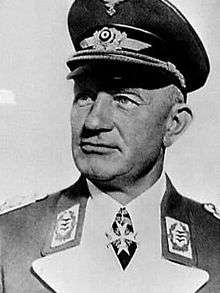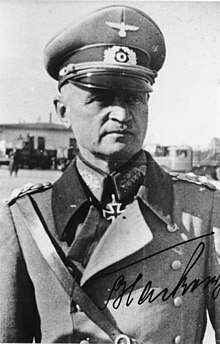25th Army (Wehrmacht)
The 25th Army (German: 25. Armee) was a World War II field army of the German Army.
| 25th Army (25. Armee) | |
|---|---|
| Active | November 1944 – May 1945 |
| Country | Germany |
| Branch | Army |
| Type | Field Army |
| Engagements | World War II |

History
The army was formed on 10 November 1944 in the Netherlands from the staffs of the Armed Forces Commander of the Netherlands and Armeeabteilung Kleffel (previously known as "Narva Task Force").[2] The designation as "army" was for most of the command's existence a deception measure as it did not command more than three divisions until April 1945.
25th Army held the northern-most position of the German front line of the Western Front in late 1944 and 1945, with its right (western) flank anchored on the North Sea and its left (eastern) flank adjoining the 1st Parachute Army. Defending the western Netherlands along the Maas River from the North Sea to Arnhem,[3] its primary opponent was First Canadian Army.
It was commanded successively by Friedrich Christiansen, Günther Blumentritt, and Philipp Kleffel. From November 1944 until April 1945, the 25th Army was subordinated to Army Group H and subsequently was transferred to the Northwest High Command (OB Nordwest).
On 7 April 1945, the 25th Army was converted into the Netherlands High Command (Oberbefehlshaber Niederlande) under command of Generaloberst Johannes Blaskowitz to defend Festung Holland , the Dutch western provinces.
Two days after the surrender of the Northwest High Command to British 21st Army Group, Generaloberst Blaskowitz surrendered his command to the Allies at Wageningen on 6 May 1945.[4]
Commanders
| No. | Commander 25th Army | Took office | Left office | Time in office | |
|---|---|---|---|---|---|
| 1 | General der Flieger Friedrich Christiansen (1879–1972) | 10 November 1944 | 28 January 1945 | 79 days | |
| 2 | General der Infanterie Günther Blumentritt (1892–1967) | 29 January 1945 | 28 March 1945 | 58 days | |
| 3 | General der Infanterie Philipp Kleffel (1887–1964) | 28 March 1945 | 7 April 1945 | 10 days |
| No. | Oberbefehlshaber Niederlande | Took office | Left office | Time in office | |
|---|---|---|---|---|---|
| 1 | Generaloberst Johannes Blaskowitz (1883–1948) | 7 April 1945 | 6 May 1945 | 29 days |
References
- Nafziger
- Tessin, p. 221
- Stacey, p. 446
- Axis history
Sources
- Stacey, C. P. (1960). The Victory Campaign, The Queen's Printer and Controller of Stationery, Ottawa.
- Tessin, Georg (1976). Verbände und Truppen der deutschen Wehrmacht und Waffen-SS im Zweiten Weltkrieg 1939-1945 (Volume IV), Biblio Verlag, Osnabrück. ISBN 3-7648-1083-1.



